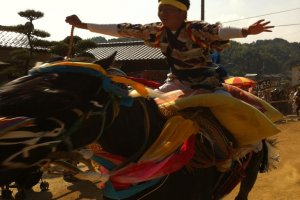Kamo Shrine stands in the valley of a little river that runs down to the Seto Inland Sea at Kikuma. It’s an area that’s utterly typical of rural Japan—the river with its Showa era concrete bridges and white egrets, rambling old houses with elaborate roof tiles, rice paddies rising gently to stands of bamboo, which give way to forest that climbs up to the peaks of local mountains.
This is the landscape that gave rise to the running of horses at the shrine. Not so long ago, hundreds of horses were kept here to help the farmers extract logs from the mountains as part of their forestry management, and to bring mikan and game down from the foothills. These horses are known as no-uma. As a break from the daily routine, the horses were run hell for leather up the slope to Kamo Shrine once a year in the autumn festival.
Today the event is an Intangible Cultural Property, and there are just 18 horses kept by local farmers for the sole purpose of running in the festival. The horses are ridden by young boys in their early teens.
The event starts at 8:00 am in the slanting morning light soon after sunrise. A stout, elderly gentleman with a microphone explains the 600-year tradition we’re about to witness, and gently suggests that we observe some basic rules; Don’t touch the horses, and avoid getting too preoccupied with your camera that you fail to notice that a horse is coming right for you.
The significance of this warning becomes immediately apparent with the first run. The horses gallop past the roughly erected barriers within inches, and the boy riders lean right in where you might be holding your camera. It’s incredibly exciting. The boys are dressed in multicolored clothes bedecked in ribbons, and the beautiful horses are adorned with padded and embroidered caparisons. After their dash up the slope beside the shrine, the panting, snorting horses are led back down by handlers in white jodhpurs and purple happi coats. Not everything goes smoothly—sometimes a horse goes where it shouldn’t, and one even ended up in the pond at the top of the hill. The stout gentleman on the mic provides droll commentary with personal comments about the young riders;
“That was good! Well done! Ryoma you got some applause there!”
One young rider had a scab running down his cheek from his eye showing how hard he had been practicing for the day.
Besides the horses, there are parades of omikoshi god boxes, and a bizarre horse-like thing made of fabric and wood carried by a legion of men in festival attire. There are also performances of the local version of the dragon dance, which is heart-stoppingly daring.
The road leading to the shrine is lined with stalls serving festival food and drink. The locals swill their own beer, and it’s tempting to join them, with beer bought from the stalls. The horse running ends at about 11 am, making it a conveniently short but intense spectacle for the busy traveler.































